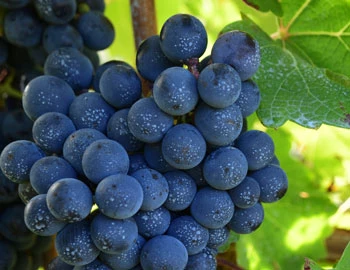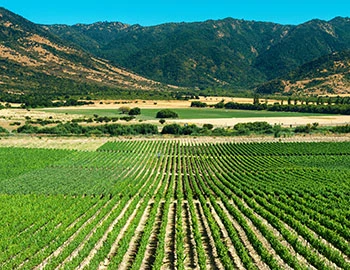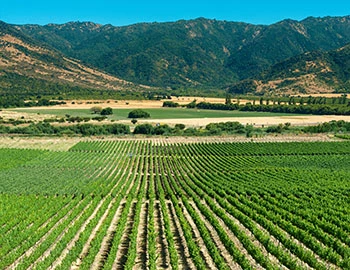Cabernet Sauvignon Gran Reserva 2020
Colchagua Valley, Terra Noble, 750 ml

| Grape variety: | Cabernet Sauvignon |
| Producer: | Viñedos Terranoble |
| Origin: | Chile / Valle Central / Colchagua |
Description
Rich, concentrated and complex Cabernet Sauvignon. At first dark berries and cassis dominate the nose. Afterwards also noble wood, vanilla and smoky tones are noticeable. Dense, rich structure, powerful body and long finish.
Attributes
| Origin: | Chile / Valle Central / Colchagua |
| Grape variety: | Cabernet Sauvignon |
| Label: | Vegan |
| Ripening potential: | 1 to 8 years |
| Drinking temperature: | 16 to 18 °C |
| Food Pairing: | Châteaubriand, Filet Wellington, Wild specialities, Wild fowl, Spiced grillades |
| Vinification: | fermentation in steel tank, fully destemmed |
| Harvest: | hand-picking |
| Maturation: | in used barriques, in large wooden barrel/foudre |
| Maturation duration: | 12 months |
| Volume: | 14.0 % |
| Note: | Contains sulphites |
Viñedos Terranoble
Soon after their arrival, the first Spanish colonists were already remarking the ideal vine growing conditions in Chile. In this country of great contrasts, embedded between the Andes and the Pacific Ocean, the many wine regions differ significantly through micro-climate, topography and altitudes, and geological properties. TerraNoble owns vineyards in three different regions and so can provide different varieties with the most suitable growing conditions.
The big estate La Higuera stands in the Maule valley, in the southern part of the Central valley, some 250 Km from the capital Santiago, and cultivates a wide range of grape varieties. Further north, a Mediterranean climate nurses the Colchagua Valley which fits particularly well to the needs of the Cabernet Sauvignon, the Carmenère and the Syrah grapes: in Los Lingues at the foot of the Andes where the offset temperature reaches 20°C between night and day, and in Los Cactus along the coastline. The Casablanca Valley, strongly influenced by the nearby Pacific with morning fog and little rain, is more suiting for other varieties like the Chardonnay or the Sauvignon Blanc.

Cabernet Sauvignon
The backbone of Bordeaux
The Cabernet Sauvignon gives the Bordeaux its backbone, yielding deep violet wines with powerful tannins and endless ripening potential. It is the top dog in Médoc, and is placed in all five premier crus of Bordelais. When young, it often appears strict and unapproachable, but with advancing years, its tannins round off. It is wonderfully velvety, and yet always maintains its freshness. Typical flavours include cassis, graphite and cedar. Wherever Cabernet Sauvignon is found, Merlot is not far away. It complements the robust structure of Cabernet with softness, fruit and richness. The Cabernet Sauvignon is the most-exported vine in the world. It delivers persuasive qualities in Italy as an ingredient of the Super Tuscan, or as the flagship variety from California. There, it is lovingly titled “Cab Sauv”. Meat fans should be aware that it fantastically accompanies a grilled entrecôte. The family tree of Cabernet Sauvignon is surprising: its parents are Cabernet Franc and the white Sauvignon blanc.

Colchagua
Colchagua Valley: a hot spot for top red crus
Some 200 kilometres south of Santiago, Colchagua Valley comprises the southern part of the Rapel Valley, which in turn is a sub-zone of the great Central Valley (Valle Central). In the last 20 years, Colchagua has increasingly issued super-premium wine from red varieties, such as Cabernet Sauvignon, Carménère and Syrah. Many of the newly established vineyards for top wines are located on steep slopes in high-altitude hill zones.

Valle Central
Valle Central: the heart of Chilean viticulture
Valle Central comprises the four most important wine-growing areas in Chile. It starts in the southern outlying districts of the capital, Santiago, and stretches around 400 kilometres to the south, ending at the city of Parral. Red Bordeaux varieties occupy over 70 percent of total vineyard area. Depending on how strongly the particular microclimate is influenced by the cool influence of the Andes or the Pacific, stylistically varied wines result. Specialties like Carménère, Syrah and Carignan are gaining ground.

Valle Central
Valle Central: the heart of Chilean viticulture
Valle Central comprises the four most important wine-growing areas in Chile. It starts in the southern outlying districts of the capital, Santiago, and stretches around 400 kilometres to the south, ending at the city of Parral. Red Bordeaux varieties occupy over 70 percent of total vineyard area. Depending on how strongly the particular microclimate is influenced by the cool influence of the Andes or the Pacific, stylistically varied wines result. Specialties like Carménère, Syrah and Carignan are gaining ground.

Valle Central
Valle Central: the heart of Chilean viticulture
Valle Central comprises the four most important wine-growing areas in Chile. It starts in the southern outlying districts of the capital, Santiago, and stretches around 400 kilometres to the south, ending at the city of Parral. Red Bordeaux varieties occupy over 70 percent of total vineyard area. Depending on how strongly the particular microclimate is influenced by the cool influence of the Andes or the Pacific, stylistically varied wines result. Specialties like Carménère, Syrah and Carignan are gaining ground.

Chile
Chile – Where fortune came from tragedy
Wine-growing in Chile was born less out of economic reasons than lifestyle. Like the rest of the world, its aristocratic landowners admired everything that came out of France. They imitated French culture, built their haciendas in French architectural styles, and took trips to France. In 1851, the first French vines were brought back and formed the basis for producing quality wines.



